- JAPANESE
- LANGUAGE
X
 THAT IS GOOD
THAT IS GOOD
Continuing on from the last issue, I’m writing another “Jomon Special” to commemorate the registration of the Jomon Prehistoric Sites in Northern in Japan as a World Heritage Site. By introducing the artists and their works that have participated in the “ARTs of JOMON” (AOJ) art exhibition held by the NPO jomonism, of which I am the representative, I will try to explain what I think of JOMON and how it is connected to art and subculture.
The first artist I would like to introduce is Takeshi Horie. Mr. Horie is a pottery restorer, and also an artist who visualizes the knowledge he has gained from working with actual Jomon artifacts in the form of art. His work “Another Way to Use Rope: Cutting Stones”, which we exhibited at the AOJ held at Spiral Garden in 2014, is a contemporary looking work of art that, at first glance, you might think, “What part of this is Jomon?
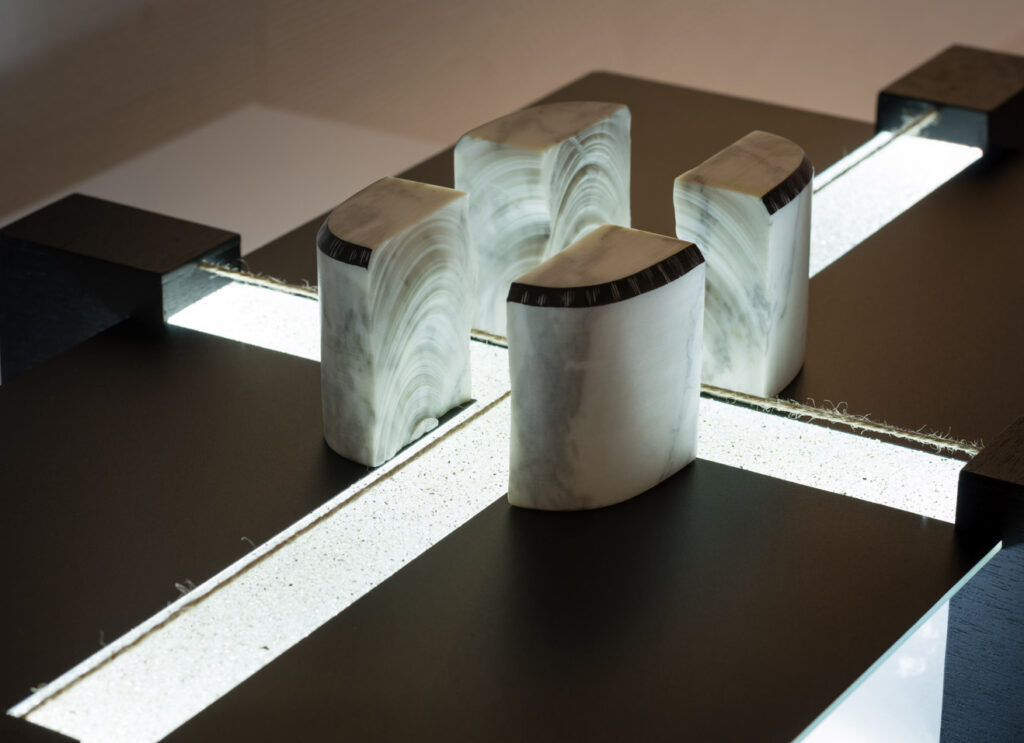
Stones have been an important tool to support people’s lives since the Jomon period and even before, the Paleolithic period. From polished stone axes for chopping wood, to stone plates, to ornaments made of jade, various processing methods have been developed over thousands, tens of thousands of years to process various types of stones.
One such technique is to use a hemp string to cut stones. As I write this pompously, I also learned about this technique through this work by Mr. Horie. The “abrasive cutting technique” of breaking up hard rocks was introduced from Siberia to Hokkaido at the end of the Paleolithic period, and further south to the Itoigawa and Omi regions of Niigata Prefecture and surrounding areas. It is a technique of rubbing stones by using hard and fine sand as an abrasive and rubbing it with a hemp string.(※Ref①)In “Another Way to Use a Rope”, Takeshi displays a stone and hemp cord that he actually cut with a rubbing technique on a lighted stand, sublimating a technique that was actually used in ancient times into art. The cut surface of the stone is also beautiful. If contemporary art is a visualization of a concept, then this work can be called a work of contemporary art that connects prehistoric times with the present.
The other work of Mr. Horie I would like to introduce is “Ultra Sculpture”.
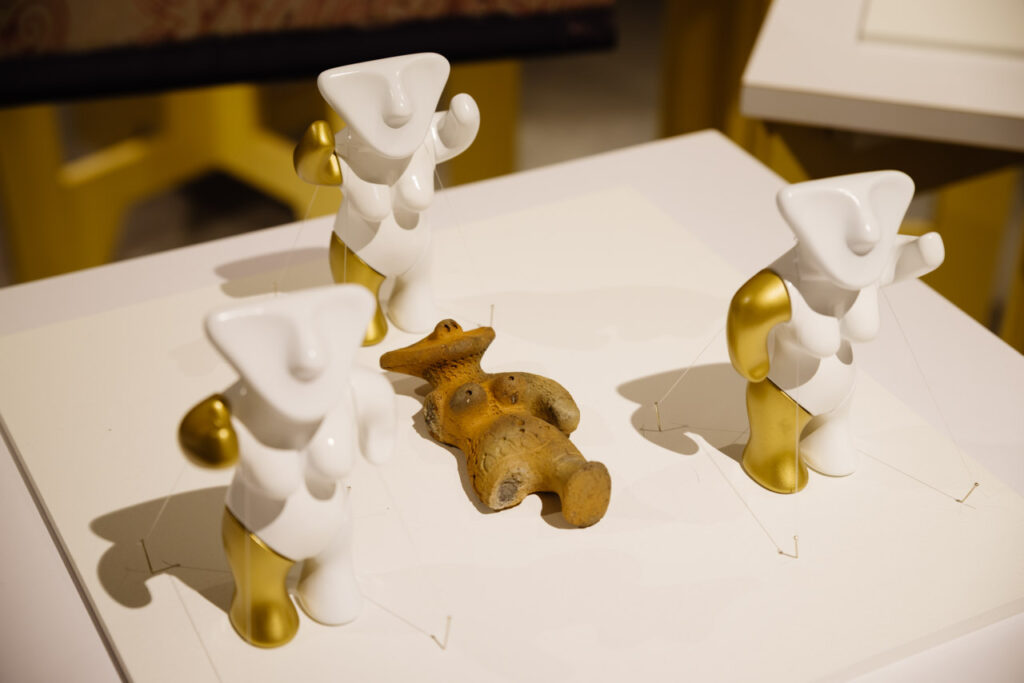
“Ultra Sculpture” was created taking motif after clay figurine excavated from the Urushita site in Akita Prefecture (the one in the work is a replica made by Mr. Horie). It is made of PVC (polyvinyl chloride), so-called sofvi. Many of you may have had sofvi of Ultraman or Kamen Rider, but nowadays, sofvi are not only toys for children, but also works of art by various artists, and have become an established genre in the subculture of “collectible toys” and “art toys”.
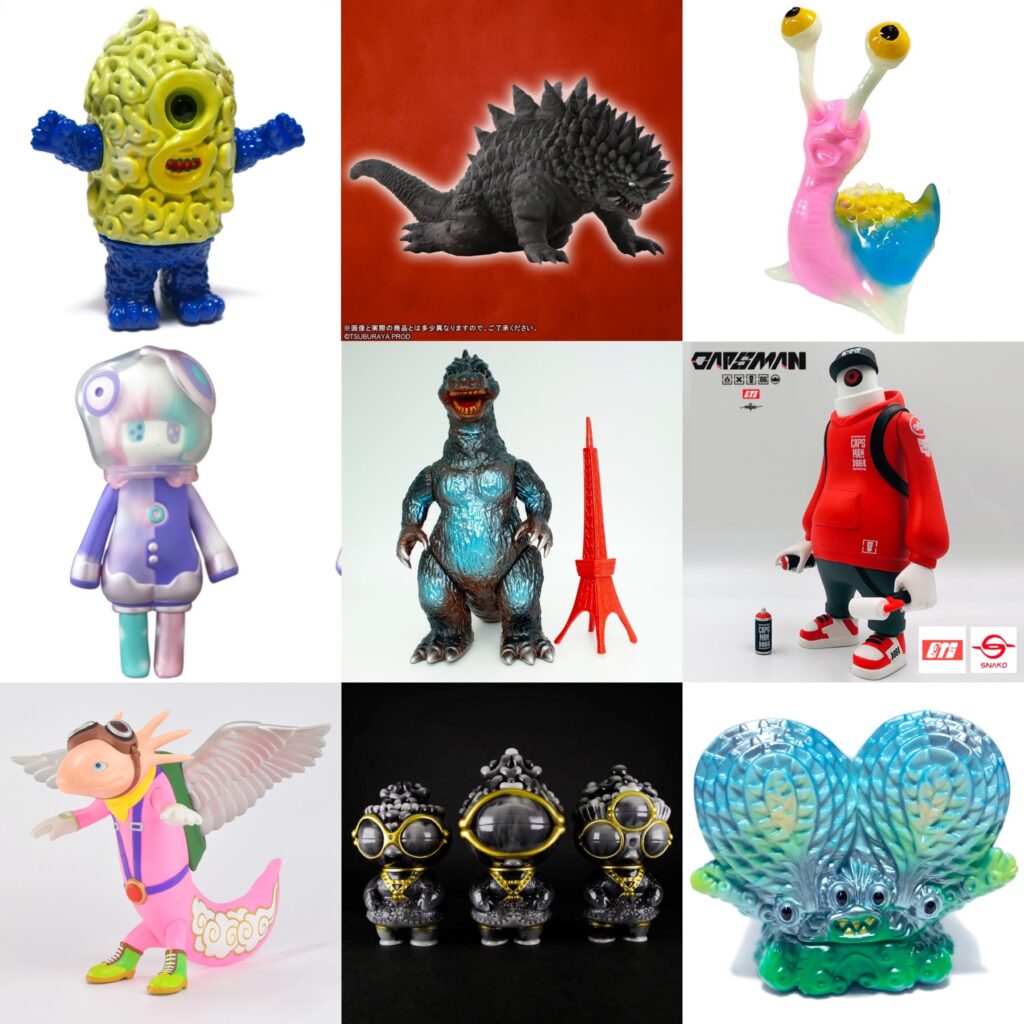
Of course, sofvi is popular overseas as well, but in my opinion, the spirit of animism that originated in the Jomon period is behind the creation of such a wide variety of sofvi in Japan. As I wrote in a previous article, Jomon earthenware and clay figurines were a way of expressing awe and respect for invisible spirits and the power of nature, and as time went on, some of the fallen kami and spirits became yokai and were incorporated into subculture.
Mr. Horie’s “Ultra Sculpture” is based on the same concept, and is a wonderful visualization of the flow from Jomon to modern Japanese subculture. What all of Horie’s works have in common is that they are backed by solid archaeological knowledge, combined with a modern concept and look, and that they are all very intricately finished.
Next, I would like to introduce Mr. Takayuki Takeya. Many of you may know Mr. Takeya from his work on the sculpt of Godzilla in “Shin Godzilla” and the super-sized giant in “Attack on Titan”. His work ranges from original artistic works to creature sculpting for commercial works such as the aforementioned, to action figure design/production, and he has many fans overseas.
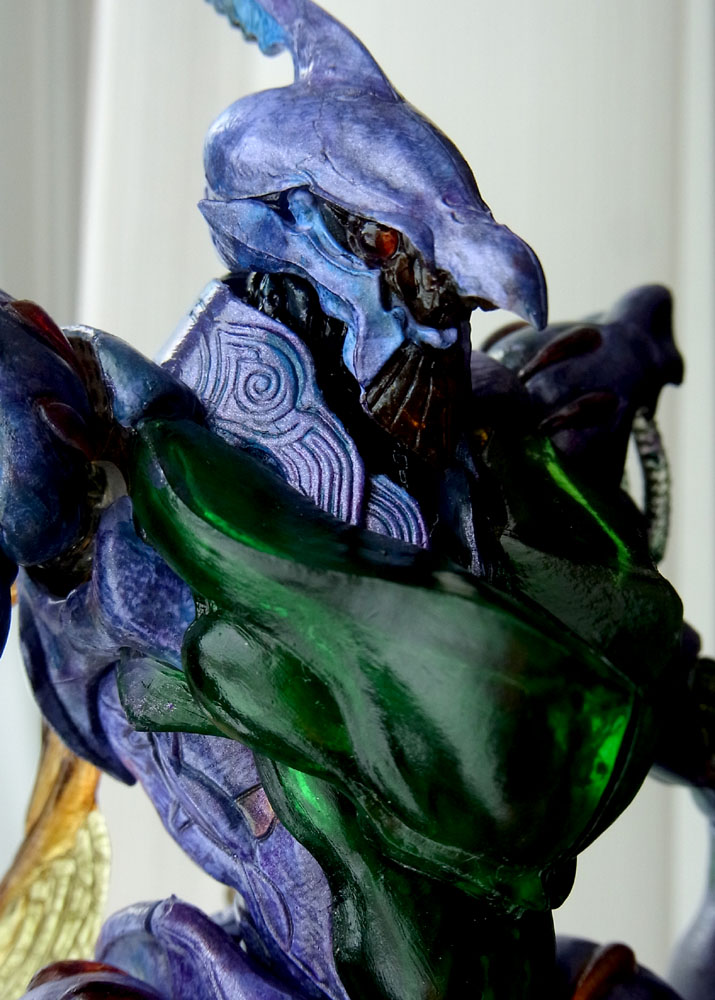
I became a fan at first sight when I saw his work in the hobby magazine “S.M.H.” (*Reference 2), and he is one of the artists who have influenced me the most in my work. I had always been curious about the Jomon and Celtic detailing in Mr. Takeya’s work, and when I saw “Nikune kamui”, I thought, “This is it! I was so impressed that I took the plunge and asked to exhibit at AOJ.

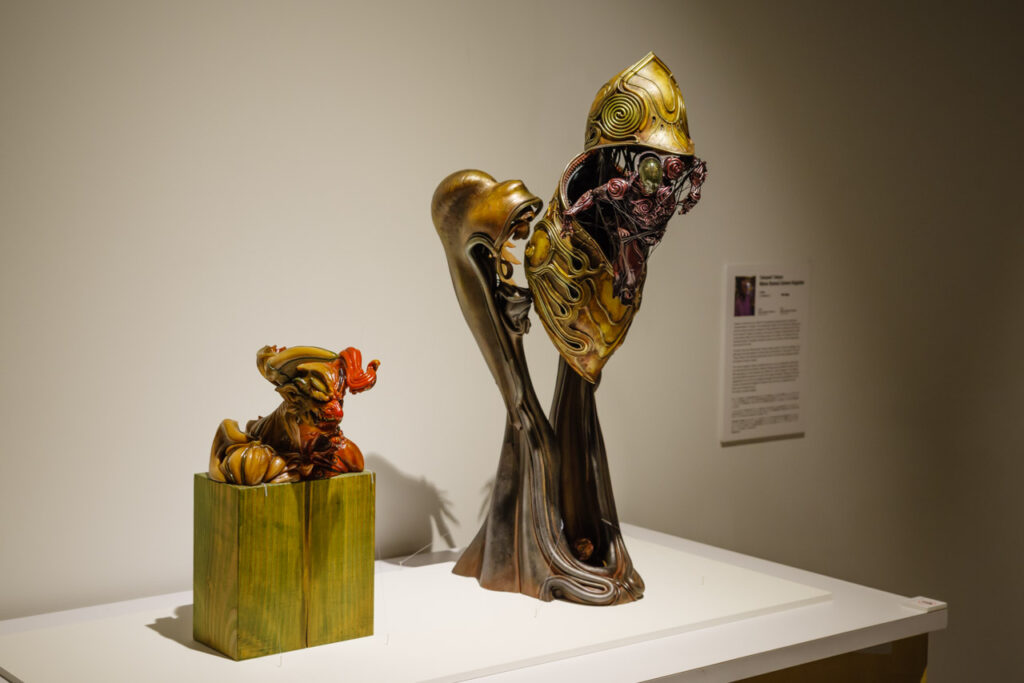
“Nikune Kamui” is the Ainu word for “oni(ogre, demon)” (Kamui=kami), but unlike the common image of an oni, this one is much more gigantic.The left half of the demon’s body is decorated with undulating horns and swirling patterns based on Jomon earthenware, while the right half of the body has a relatively clean design based on Yayoi design(histric periof after Jomon) as a contrast.
It’s just perspective, but it’s generally accepted that modern Japanese are a mixture of Jomon and Yayoi people, with more than 70% of their DNA being of the Yayoi lineage. In my opinion, the Jomon are not a single race, but rather a moderately mixed group of people from the north, south, etc. The idea that the Japanese are a single race is an illusion. The more cultures and races are mixed, the more interesting and strong they become. Of course, there will be conflicts, but I believe that such chaos and chimerism is the driving force for human progress.
“Nikune kamui” is not only an incredibly cool piece of art, but also a visual expression of the influence of the Jomon on modern subculture, and a symbolic representation of the intermingling of cultures.
Last but not least, I’d like to introduce some of the works that I exhibited at AOJ. First of all, I would like to introduce my contemporary art project “YAOYOROZ”. This is a series of Buddhism, Shintoism and other deities’ statues made using the latest technology, 3D printing… I introduced it when I started this project back in 2012, but now 3D printing has become so widespread that it is possible to make 3D prints of reasonable quality at home.
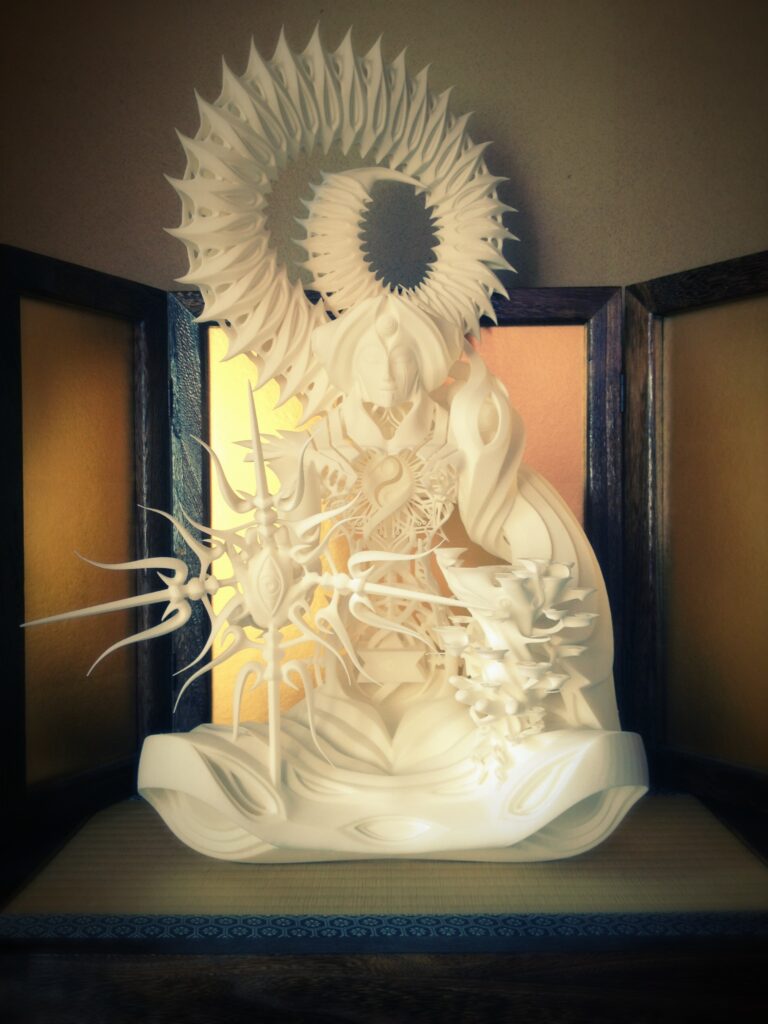
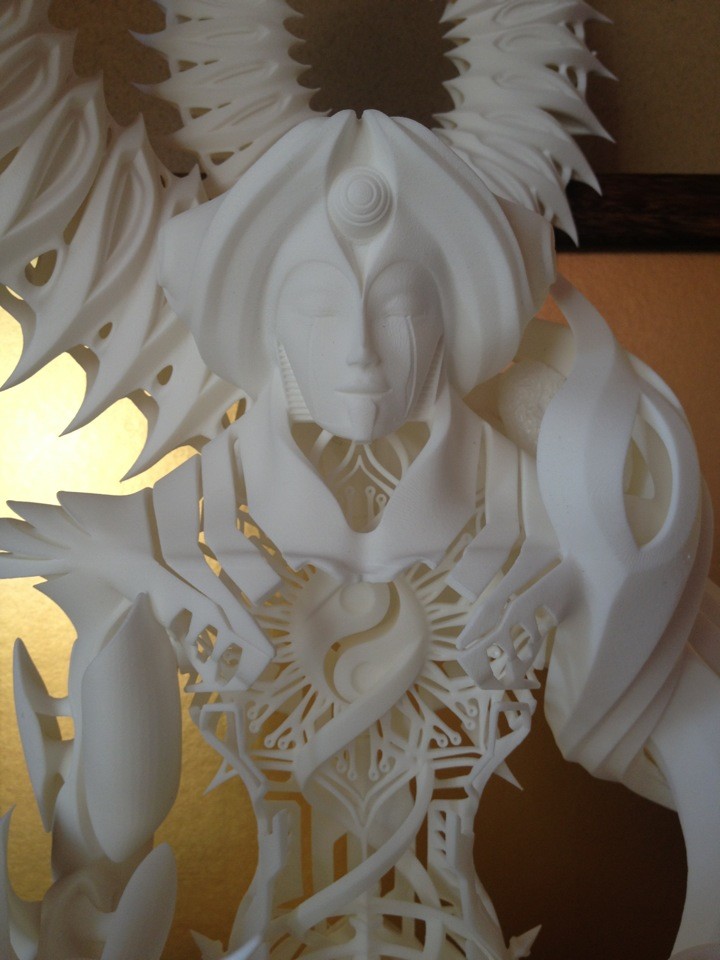
YAOYOROZ’s first work, “Bhaisajyaguru”
It’s not just “contemporary” because it uses the latest technology. The shape of this statue contains all of the Japanese culture that has influenced me: Jomon, Buddhism, and subculture. Many cultural influences have passed through my filter, condensed, and unfolded like a mandala on a single statue. Some of you may be wondering, “Why a Buddhist statue is Jomon art?” In my opinion, the animistic spirituality of the Jomon did not end with the Jomon period. Since the Jomon period, various cultures, including Buddhism, have been introduced from the continent to Japan, but the spirit of Jomon has been fused with new cultures and passed down from generation to generation. In the creation of Buddhist statues, especially when we see itto-bori, or the carving of Buddhist statues out of wood, we see that rather than simply creating a statue of Buddha, the artist is interacting with the natural power of the wood and harmonizing it with the power of the human will and design without resisting that power. This is a very animistic work.
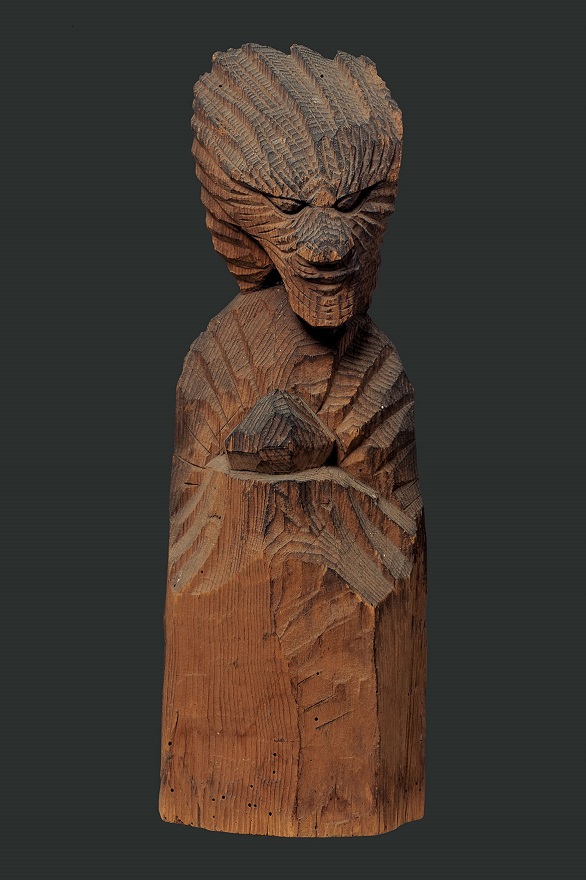
”ASURA” is one of the works of the YAOYOROZ project, which was exhibited at AOJ in Kuala Lumpur (Malaysia, 2017) and other events.
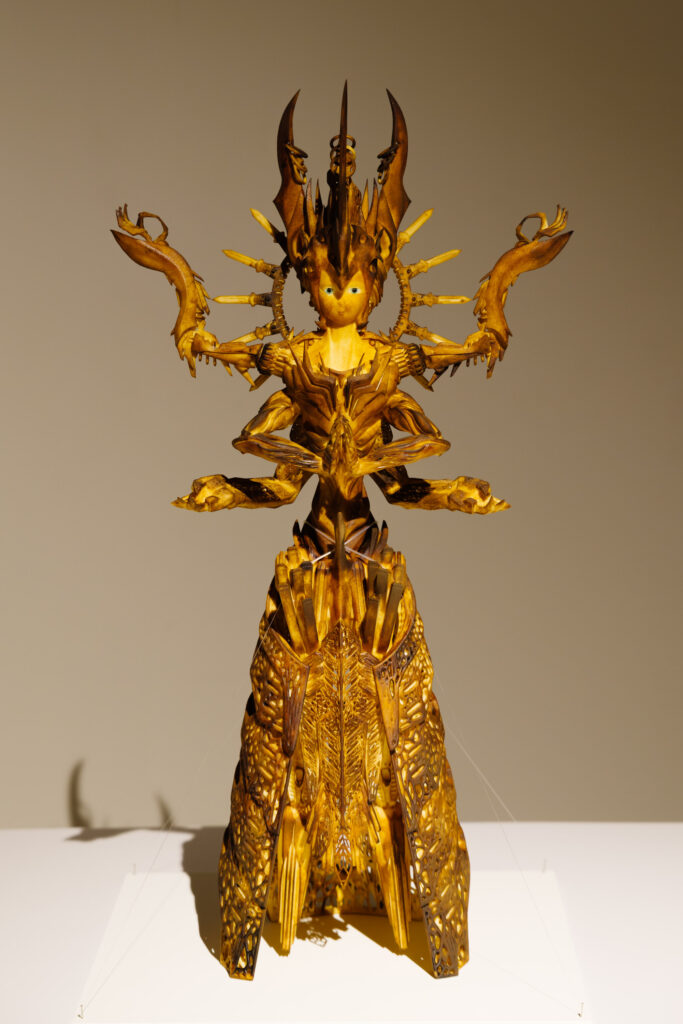
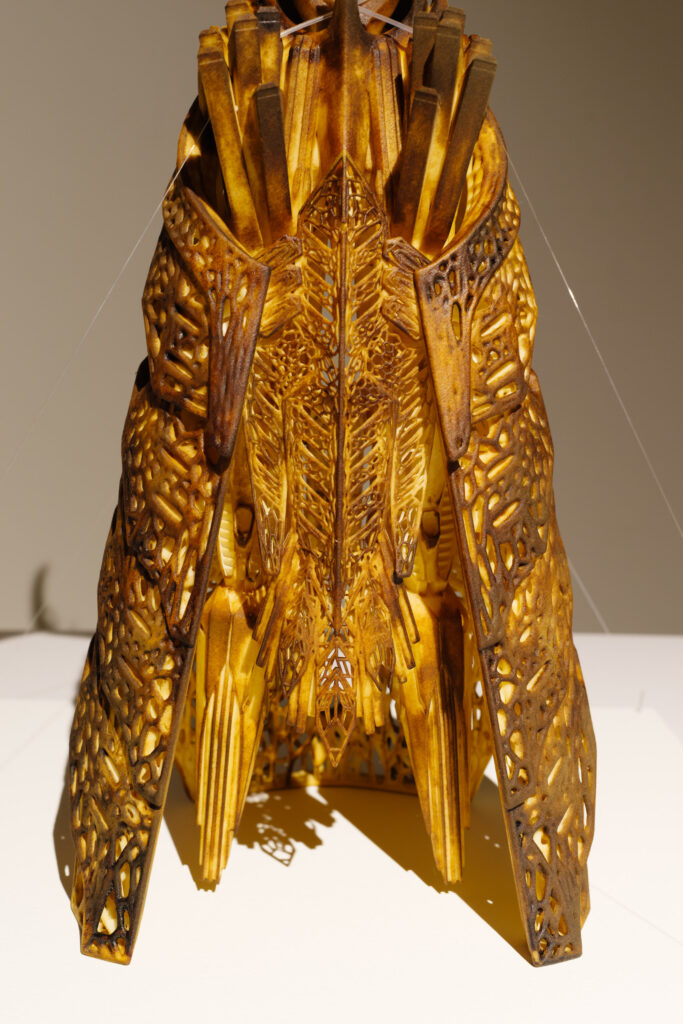
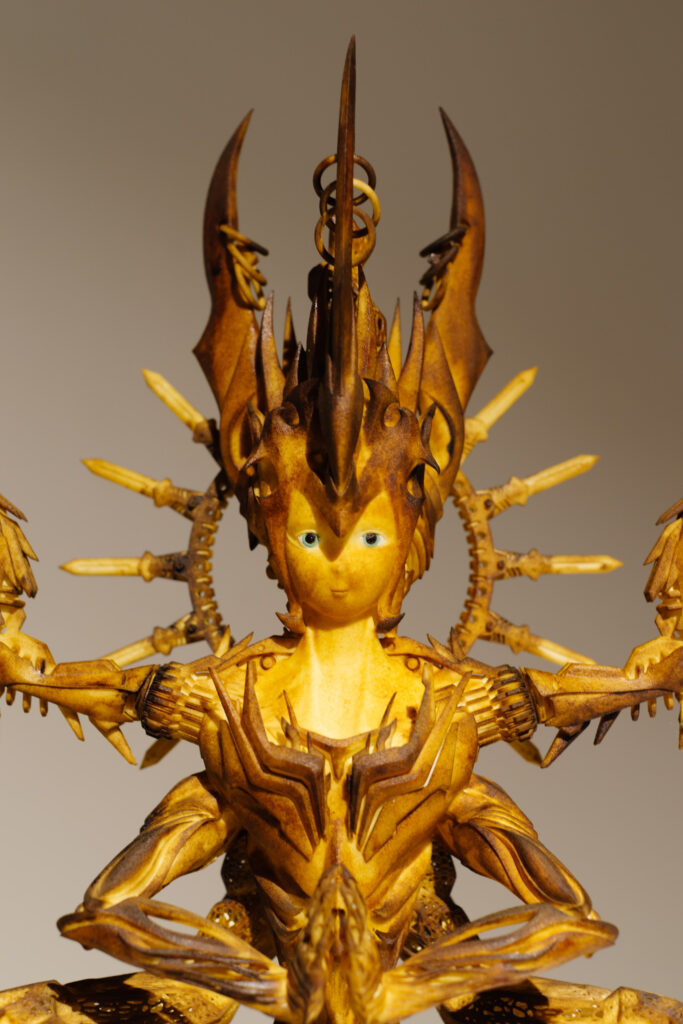
photo by Yoshiaki Hirokawa(縄と矢じり)
I used Asura as the base motif, but fused it with subculture-like robot design elements and shapes using generative design (*Reference 4). By removing the boundary between different elements, such as the past and the present, design by humans and design by software, we have created a statue that is appropriate for the present and for the future. The shape created by 3D printing, especially the lower part of the hakama(pants), is a nested mesh shape that could only be created by 3D printing.
One of the unique features of ASURA is the surface finish, which is done in urushi lacquer(natural varnish made from sap ) by the urushi artist Mitsumi Irahara. Urushi is often associated with shiny, polished crafts, such as traditional bowls and dishes, but it has been used since the Jomon period, as an adhesive to fix arrowheads and as a paint on the surface of Jomon doki(earthenware) and dogu(clay figures). ASURA’s 3D printed material is nylon, a chemical material, but by finishing the surface with urushi, a natural material, and blending different elements into one, the result is an unprecedented form that looks like a wood sculpture, and a milestone work that combines contemporary Japanese “subculture,” “art,” and “technology.

Well, that was my attempt to tell you what I think JOMON is, while introducing the artists who have participated in the AOJ over the past two issues of Jomon Special. How was it? There are many other great artists who have participated in AOJ, and I’d like to introduce them again if I have the chance!
※Ref➀
About Polishing Technology “Primitive and Ancient Optical Technology”
※Ref➁
A magazine that was published by Hobby Japan. First published in 1995, ceased publication in 2000. The magazine featured works by such superstar sculptors as Kenji Ando, Yasushi Nirasawa, Takayuki Takeya, Katsuya Terada, Takuji Yamada, Jun Kamei, Eisaku Kito, MAX Watanabe, Keita Amemiya, Ryuichiro Kutsuzawa, Mototaro Araki, Shungo Yazawa, Kazuhiro Haga, Keisuke Kishi, and H.R. Giger (titles omitted). There was a wide range of content related to modeling, including figures, dioramas, illustrations, manga, short stories, and columns. The figures are mainly garage kits and one-of-a-kind works, so the content is more art-oriented.
※Ref③
Takeya’s Art of Modeling as seen in Nikune kamui (Only in Japanese)
http://www.takeyatakayuki.com/sphtml/zoukeiTc.html
※Ref④
Generative design is a design method that uses computer software to autonomously create an optimal design from a set of system design requirements. Based on interactively specified requirements and goals (e.g., preferred materials, manufacturing processes, etc.), a design in a ready-to-manufacture state is automatically generated as a starting point or final solution for the work.
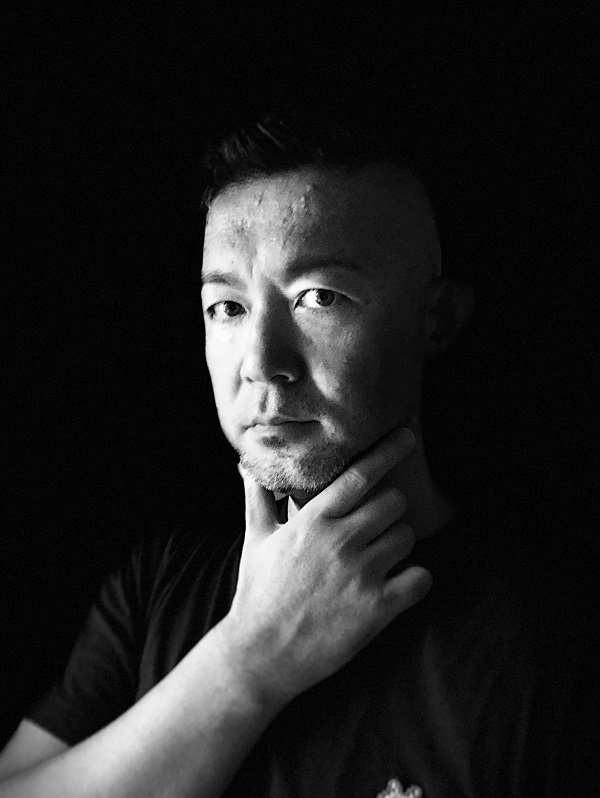
Taketo KOBAYASHI Post-digital artist
ARTSTATION
Taketo Kobayashi (artstation.com)
Instagram ID
@humanoise
After having experience of 3D graphics and animation at Tokyo Institute of Technology creative laboratory, and Gonzo Co., Ltd., Taketo started his own project as an artist. Using digital technology like CG, 3D printing as his “brush”, Taketo creates a wide variety of artworks from 3D printed sculpture to animation. In a collaboration project XSENSE, Taketo utilizes CGI in street art to create murals(Denver, CO, USA), also using his unique style animation for stage design and collaborated with contemporary Noh theatrical group. In addition to creating his own artworks, Taketo curates the group art show “ARTs of JOMON” hosted by Japanese non-profit JOMONISM, keep introducing contemporary artists/artworks influenced by ancient Japanese Jomon culture.(Aomori Museum of Art / Spiral Garden / Denver International Airport / Kuala Lumpur)
It is Taketo’s mission to make invisible things, emotions, energy, next dimensions of consciousness into “shapes”.
Project/Art history(excerpt)
PROJECTS Digital G-O-D, UltraSuperNew gallery, Singapore, Jan 2020
Haw Par Villa RE•MIX
Chinese Cultural Centre, Singapore , Jan 2020
”Light to Night Festival” Projection mapping at Asian Civilization Museum, Singapore , Jan 2020
A SIGN OF THE TIMES EXHIBITION, Singapore , Jan 2019
”ARTs of JOMON” exhibit @ISETAN KL, Malaysia , Aug 2017, curation&direction
“Colorado Crush”, a mural festival in Denver, CO. Sept 2016, created artwork
“DMS” Collaboration with Canon June 2015, created&exhibited 3D printed prosthetic leg
”Oakley Exhibition” Exhibited artworks at Oakley store Harajuku, Tokyo, Oct 2014
AWARDS “Eisen Herz” Ufab Global Creative award Finalist. 2016. 3D printed cover for “Tamiya mini 4WD” using generative design
“More Than Human type-Unicorn” a 3D printed prosthetic leg. Ufab Global Creative award Finalist. 2015
“SC1-EXP” Zushi International Projection Mapping Competition, Grand Prix. 2014
“Yakushi-Nyorai”(2013)
3DCG model for 3D printing. Winning work at Digital modeling competition held by Japan Society for Graphic Science
Original CG animation ‘Matsuri’(May 2010)
Design, modeling, production coordination. A CG animation based on Japanese ‘Jomon’ culture. Created for promotion of Aomori Prefecture. Accepted at Siggraph Asia 2010. (On VIMEO: https://vimeo.com/25144961)